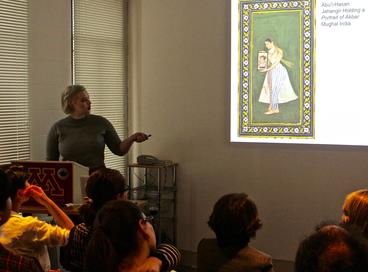
- phase completed
- phase in-progress
The Department of Art History, in the College of Liberal Arts, has a 9-member full-time faculty, enrolls approximately 30–50 students as majors, and prepares students to participate in the cultural economy at the local and global levels. Writing in this highly visual field is based on close observation and careful description of visual material (including works of fine art, popular culture, photographs, prints, films, architectural spaces, built environments, decorative arts, and illuminated manuscripts). Art History majors also produce detailed historical narratives, offer new interpretative arguments, and think critically about the role of the visual arts in human societies around the world.
Writing in Art History
In response to the question, “What characterizes academic and professional communication in this discipline?" the Art History faculty characterized art historical writing as:
- descriptive and predicated upon careful visual analysis
- logically precise in its assembly, analysis, and presentation of evidence and argument
- transparent in its transmission of information and ideas
- synthetic, bringing together different forms of evidence to bear on historical, aesthetic, or theoretical problems and disparate historical contexts, artifacts, or ideas
- interpretative, creative, and original
With these characteristics in mind, the department faculty approved the following description of discipline-specific writing to guide our work in relation to WEC:
"Art historical writing does more than merely report on pre-existing knowledge, or simply represent research that the writer has undertaken and amassed elsewhere. It is rather the means by which knowledge is generated for specific audiences (scholars, students, museum patrons, movie and gallery goers, professional colleagues, etc.), and it is thus a key site in which art historical research and thought take place. In other words, writing is a form of thinking."
Writing Abilities Expected of Art History Majors: Menu of Criteria
The following list of faculty-generated grading criteria appear in various forms in assignments across our curriculum, as well as in grading guidelines and student-facing rubrics. Most explicitly, we use a generalized restatement of all 10 criteria for use among students and faculty mentors involved in our capstone class, and we have adapted them for use as direct measures in annual assessments.
Description: Where specific works of art are investigated in isolation or otherwise used as a source of evidence, the text includes careful and detailed descriptions, so that:
- readers can clearly see and appreciate key observations related to the work.
- readers can clearly follow the writer's steps from observation, to analysis, to conclusion.
Historical Contextualization: The text includes accurate and richly detailed historical contexts for art objects, historical actors, ideas, and/or events, so that:
- the conclusions offered are historical in nature, related to a chronological narrative of change-over-time and/or claims to period specificity.
- the conclusions offered are not based on (or not based only on) subjective opinion.
Inquiry: The text explains its area of inquiry, so that:
- the reader can discern the nature of the conclusions offered (e.g., a report on already-known information and/or ideas; a new interpretation of already-known information and/or ideas; a contribution of new information and/or ideas.)
- the reader understands the decisions behind the research conducted.
Research: The text reports on, synthesizes, and contributes to some combination of primary, secondary, and/or theoretical textual sources, as well as non-textual sources, e.g., images, objects, buildings, films, or performances, so that:
- the conclusions offered are based on evidence.
- the conclusions offered draw from and build upon a variety of resources.
Argument: The text includes an articulate and persuasive argument, so that readers know early on what to expect and why it matters.
Organization/Clarity: The text is organized in a logical manner, so that readers can follow a lucid historical account and a consistent train of thought.
Analysis/Synthesis: The text develops and fully prosecutes an argument throughout, so that the presentation of all forms of evidence (e.g., historical information, visual observation, analysis of existing literature) clearly relates to and further develops the core thesis.
Voice/Stakes: The text is written in a confident and distinct authorial voice, so that readers understand that an author is responsible for the text's many decisions (from choice of subject matter, to research path, to conclusions drawn, to writing style - which may include narrative, objective, poetic, and other forms of authorial "voice").
Mechanics: The text includes minimal grammatical and spelling errors (through proofreading and self-editing) so that content is not obscured by distracting mechanical mistakes.
Citations: The text includes professional citation practices (typically in the Chicago Manual of Style format), so that readers can trust the veracity of the information presented and know how to retrace the researcher's steps.
Highlights from the Writing Plan
The Department of Art History initiated its engagement with WEC in AY2013-14. By 2020, the department had developed, implemented, and assessed three editions of a writing plan. In these plans, the faculty outlined a broad strategy encompassing comprehensive research into student experience and location of writing and writing instruction throughout its curriculum, a robust emphasis on student writing in department culture, and particular attention to developing sustained systems of support for writing at the capstone level. This latter aim has been successfully achieved with an innovative and enthusiastically reviewed three-credit support course, the “Art History Capstone.” Student projects developed in this course are nominated for an award, an achievement the department celebrates with a public symposium.
Currently implementing its Legacy-Edition Writing Plan, the department has turned from focusing on capstone-level instruction to creating significant learning and writing experiences in its large-enrollment intro-level survey courses. More specifically, the faculty seeks to incubate a program that will support faculty members who teach these courses tools for inaugurating systems of art historical writing and thinking. Working in clusters, faculty will develop a series of instructional toolkits—materials and resources that align with a set of early writing-learning goals—and are compiled into an “Intro to Art History Teaching Commons.”
